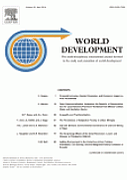Sous-évaluation du taux de change et poussées d’exportations africaines : que nous apprend une analyse par produits ?
12 juillet 2022

Carrere C., de Melo J., (2012) “Fiscal Spending and Economic Performance: Some Stylized Facts”, World Development, vol. 40(9), pp. 1750-1761